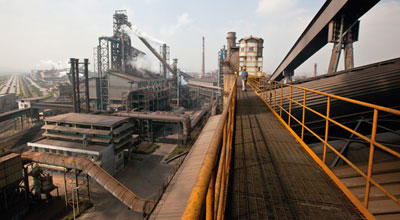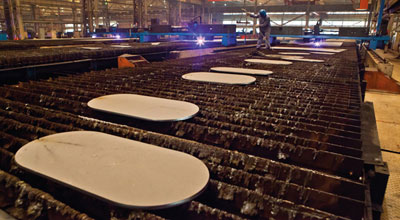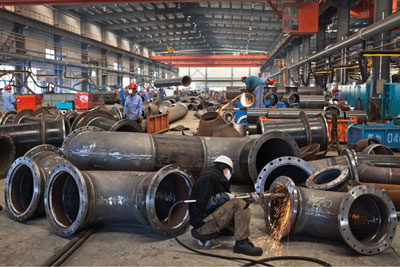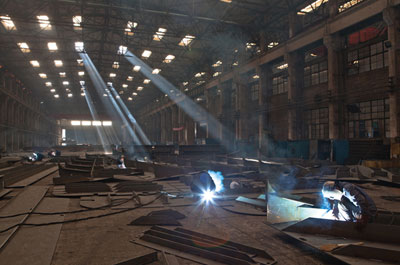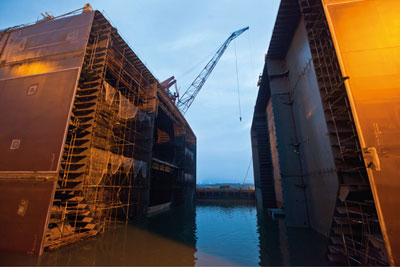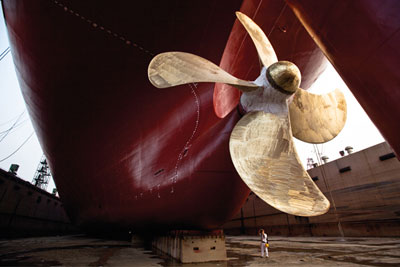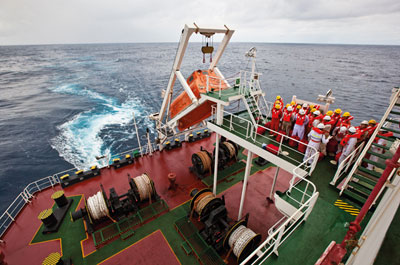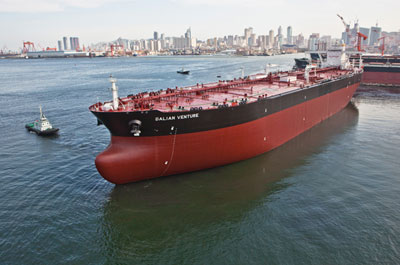中國工業革命的驅動器!
|
????鋼鐵和造船是最能反映中國的非凡增長及轉型的兩個行業。 ????這在常駐香港的攝影師鮑皓昕(Basil Pao)的作品《雙船記——華光海運60周年紀念冊》中被生動地展現出來。本文展出了從紀念冊中挑選出來的幾張照片,描繪了在中國建造超大油輪和散貨船的過程。這些船前往世界各地,裝載鐵礦石、煤炭和原油,然后返回中國,推動正在那里進行的工業革命。 ????值得注意的是,就在20年前,中國還是全球鋼鐵業和造船業的一個相對弱小的競爭者。今天,它是這兩個行業的領先者。 ????鋼鐵在任何工業國家都是最重要的大宗商品。它是建筑、高速公路、橋梁、鐵路等基礎設施和各種各樣的消費品的重要組成部分。中國成為世界最大的鋼鐵制造國也許已經是舊聞,但人們容易忘記,這一成就的驚人的實現速度和規模。 ????在2000年,即開始改革開放22年后,中國的鋼鐵產量占全球總產量的15%,中國大陸只有兩家鋼鐵公司進入世界前10名。今天,中國生產了全世界大約一半的鋼鐵,在世界前10大鋼鐵公司中有5家來自中國,在前20大鋼鐵公司中中國有10家。 ????鐵礦石消費隨著中國的鋼鐵產量而水漲船高。中國是世界最大的鐵礦石生產國,但其礦石含鐵量較低,只有大約10%,而進口鐵礦石含鐵量在60%甚至更高。這也迫使中國成為全球最大的鐵礦石進口國,在2012年進口了超過7.4億噸的鐵礦石。 ????我們來縱向比較一下中國的鐵礦石進口:2000年,中國鐵礦石進口量為7千萬噸,今天進口總量是2000年的10倍以上。再換個角度:今天中國每月的鐵礦石進口量都相當于2000年的全年進口總量。澳大利亞、巴西是對中國的主要鐵礦石出口國,已經從中國對大宗商品的貪婪消費中獲得了巨大的經濟利益。 ????在將鐵礦石變成鋼的過程中,需要大量的能源。這顯然使另一種大宗商品——煤炭——愈發重要。預計從明年開始,全球的燃煤有一半是在中國點燃的。在本世紀的頭10年,中國鋼產量增加了5倍,煤炭消費量隨之增加了3倍。 ????難怪中國既是世界最大的煤炭生產國,也是最大的進口國。去年(2012年),中國的煤炭進口量年比增加了驚人的57.9%,達到2.89億噸。盡管中國近年來在綠色能源領域取得了重大進步,但對煤炭的渴求不會在短期內消退。保守估計,在未來4年,煤炭消費總量至少每年增長2%。 ????除了較少數量的煤炭經由俄羅斯和蒙古陸路運輸——只占中國煤炭進口總量的不到9%,大部分進入中國的煤炭出自更加遙遠的地方。僅來自印度尼西亞、澳大利亞和南非這三個國家的煤炭就遠遠超過了中國煤炭進口量的50%。 ????中國對以海運為主的進口鐵礦石和煤炭的需求量極大,令全球造船業自2000年以來、尤其在自2003至2008這幾年間獲益巨大。需求與租船費用相互促進上漲。然而到了2008年,全球金融危機引發需求暴跌,租借價格從歷史高點猛降至接近歷史低點。盡管如此,造船業仍然是中國的驚人增長中不可缺少的組成部分。 ????在過去10年的大部分時間里,中國對大宗散貨航運的推動促使全球好望角型(Capesize)散貨船隊顯著增長,好望角型散貨船的載重量在15萬噸至40多萬噸之間。這些船主要用于鐵礦石和煤炭的運輸,它們一共占到好望角型散貨船載貨量的90%。 ????另一類進口越來越多的大宗商品是石油。2012年12月,中國首次成為世界上最大的石油凈進口國,但絕對進口數字仍排在美國之后。預計到2015年,中國將超過美國,成為世界上最大的原油進口國。 ????中國經濟對石油越發地渴求,這也帶動了超級油輪的制造,有些油輪可以攜帶200萬桶石油。它們在運輸效率上排名第二,僅次于石油管道。 ????自2000年以來,中國對鐵礦石、煤炭和石油的需求一直在飛速上漲,再加上鋼鐵生產的普遍好轉,為中國取得造船業全球領先地位創造了絕佳的平臺。在2000年,中國還遠落后于造船強國韓國和日本,但如今,它已是世界最大的造船國。中國造船上一次領先于世界是在15世紀初的明朝永樂時期,當時鄭和帶領龐大的寶船艦隊從中國航行到東南亞和東非。 ????造船和用船是兩個完全不同的概念。香港最有實力的船王所擁有的技術在造船方面毫無價值。趙氏、辜氏、包氏、曹氏、董氏等家族掌握了風向變化的知識,在20世紀40年代末從上海遷至香港。半個世紀過后,他們又回來推動中國的對外貿易開放。 ????今天,越來越多的鐵礦石和煤炭經由中國制造的好望角型散貨船運輸,它們使用的燃料是由中國制造的超級油輪進口來的。鐵礦石和煤炭被用于生產鋼鐵,鋼鐵反過來又用于制造更多的船,帶來更多的鐵礦石、煤炭和石油……如此循環不息。這些就是交織在中國的發展故事中的主要線索,它們至今仍沒有顯示出將在短期內衰退的可能。(財富中文網) ????譯者:古正 ????照片選自《雙船記——華光海運60周年紀念冊》,重印得到了鮑皓昕和華光海運的許可。攝影:鮑皓昕。Studio 8版,2012年10月。 |
????No two industries better reflect China's extraordinary growth and transformation than steel-making and shipbuilding. ????This is dramatically illustrated in the book "A Tale of Two Ventures – Wah Kwong at 60", by Hong Kong-based photographer Basil Pao. Selected photos from that book are presented here , depicting the construction of super-sized tankers and bulk carrier ships in China, their journey around the world to obtain cargoes of iron ore, coal, and crude oil, and their return journeys to China to fuel her ongoing industrial revolution. ????It is useful to bear in mind that just 20 years ago, China was a relatively small player on the global stage in steel-making and shipbuilding. Today it is the leader in both. ????Steel is one of the most important commodities in any industrialized country. It is a crucial component of infrastructure such as buildings, highways, bridges, railways and a wide range of consumer goods. China's emergence as the world's largest steel-producing country may be old news, but it's easy to forget the remarkable speed and scale of this achievement. ????In 2000, just 22 years after the launch of the reform and open policy, China's steel production accounted for 15 percent of global output, with only two mainland steelmakers in the top 10. Today it produces roughly half of the world's steel and is home to five of the top 10 steel companies, and 10 of the top 20. ????Iron ore consumption goes hand in hand with China's steel production. China is the world's top iron ore producer, but the low iron content of its ore – around 10 percent compared to 60 percent or more in imported ore – has forced it to become the world's top importer, bringing in more than 740 million metric tons in 2012. ????To put the growth of China's iron ore imports into perspective, today's totals are more than ten times the 70 million metric tons it imported in 2000. Viewed another way, today China is importing nearly as much iron ore every month as it did in the entirety of 2000. Australia and Brazil, the main exporters of iron ore to China, have reaped significant economic benefits from China's ravenous consumption of the commodity. ????The process of turning all that iron ore into steel requires substantial amounts of energy. This is where the increasing importance of another commodity – coal – becomes apparent. It is projected that beginning next year, half of the coal burned in the world will be burned in China. In this century's first decade, the fivefold growth in China's steel output was accompanied by a threefold increase in coal consumption. ????No wonder that despite being the world's largest producer of coal, China is also the largest importer. Last year [2012] China's coal imports jumped a remarkable 57.9 percent year-on-year, reaching 289 million metric tons. Despite major recent advances in China's green energy sector, the country's hunger for coal is unlikely to wane anytime soon – conservative estimates have its total coal consumption growing by at least two percent annually over the coming four years. ????Aside from relatively minor amounts coming overland from Russia and Mongolia – less than nine percent of its total imports – the majority of coal entering China comes from much further afield. Well over half of China's coal imports come from just three countries: Indonesia, Australia and South Africa. ????China's voracious appetite for imported iron ore and coal, most of which comes from overseas, has been a huge boon for the global shipping industry since 2000, most notably in the years between 2003 and 2008. Increased demand and charter rates turned out to be a mixed blessing however – when the 2008 global financial crisis triggered a collapse in demand and charter rates plummeted from an all-time record high to near-record lows. Nevertheless, shipping today is still integral to China's phenomenal growth story. ????China's impact on bulk shipping during the fat years of the previous decade contributed to significant growth in the global fleet of Capesize bulk carriers, which feature payloads ranging from 150,000 to more than 400,000 long tons deadweight. These ships are primarily used for transport of iron ore and coal, which together constitute around 90 percent of Capesize bulk cargo. ????Another commodity which China has been importing in increasingly large volumes is oil l. China was the world's largest net oil importer for the first time in December 2012, but in absolute numbers it is still runner-up to the United States. It is expected to surpass the US as the world's top crude importer by 2015. ????The Chinese economy's growing thirst for oil has had also driven the manufacture of supertanker ships, some of which can carry up to two million barrels of oil. They are second in transport efficiency only to oil pipelines. ????Since 2000 the skyrocketing demand in China for iron ore, coal and oil combined with a massive upturn in steel production created a perfect platform for the country to take the global lead in shipbuilding. China lagged well behind shipbuilding powerhouses South Korea and Japan in 2000, but today is the world's top shipbuilder. The last time China led the world in shipbuilding was during the days of Ming emperor Yongle at the beginning of the 15th Century, when Zheng He's massive flotillas of treasure ships sailed from China to Southeast Asia and East Africa. ????Building ships and using ships are two very different propositions. That is where the expertise of Hong Kong's most powerful shipping dynasties has been invaluable. Possessing a knack for knowing which ways the winds of change would blow, the Chao, Koo, Pao, Tsao and Tung families relocated from Shanghai to Hong Kong in the late 1940s, returning half a century later to facilitate China's opening up to global trade. ????Today more and more iron ore and coal transported by Chinese-made Capesize bulk vessels running on fuel imported by Chinese-made supertankers is used to produce steel that is in turn used to manufacture more ships that bring in more iron ore, coal and oil… and the cycle continues. These are key threads intertwined with the narrative of China's development, and they show no likelihood of abating anytime soon. ????Photos reprinted with permission of Basil Pao and Wah Kwong Shipping, from "A Tale of Two Ventures – Wah Kwong at 60". Photographs by Basil Pao. Studio 8 Editions , October, 2012. |








